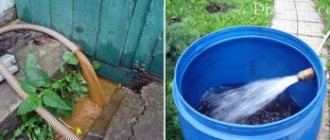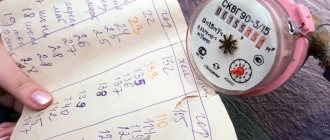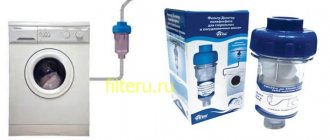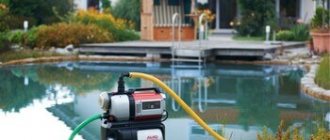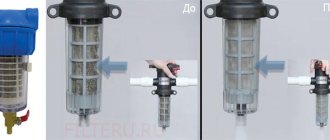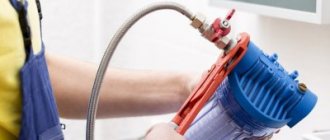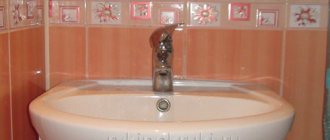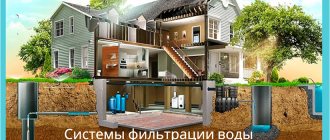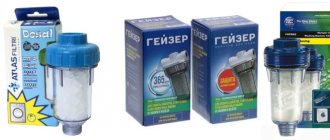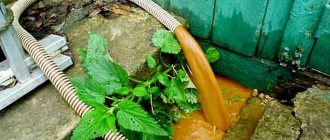Installing water filters - rules for connecting different types of filters
Everyone knows that water from the central water supply system contains a large number of impurities. We are talking about mechanical contaminants that contain particles of various sizes, chemical substances of organic and inorganic origin, viruses, bacteria and other microorganisms. You can solve the problem of impurities in tap water using a filter. However, purchasing a product is not the most important step; it is necessary to correctly install it on the pipes of the water supply system.
Installation of a coarse filter
The coarse filter has another name - mud filter. The fact is that such a device is designed to retain the largest particles of mechanical impurities. The design of coarse filters has several options, but all types are installed according to the same scheme.
The main condition that must be observed when installing the device is the location of the filter immediately after entering the apartment or house. The second condition is installation before the meter, but after the locking fittings.
The installation process cannot be called very complicated. The filter housing has a thread through which the device is screwed onto the pipe. To seal the threaded connection, you can wrap a sealant around the pipe.
When installing a water filter, you must choose its location correctly. This is due to different types of filter: perpendicular and oblique. However, regardless of the type of device, the sump cover should always be on the bottom. Otherwise, water filtration will be carried out as usual, but impurities will cause the product to fail.
Assessing the quality of water in the water supply
Some buyers choose the most expensive filter with multi-stage cleaning and modern cleaning technologies. However, this is not a guarantee of its effectiveness. The fact is that each water treatment system is designed to solve a specific problem, for example, chlorination of water or rust impurities. This means that you need to start from the composition of the water.
The easiest way is to conduct a rapid test yourself. For this purpose, there are special kits for analyzing water at home. However, they do not give a complete picture of the composition, but only show the main problem, for example, high chlorination or high iron content.
The most effective way is to take a water sample in a laboratory. You can contact the sanitary and epidemiological station of your city or an independent laboratory. The last option is more expensive, but you will get an answer faster. Based on the detailed conclusion, you will be able to assess the quality of the water and select a suitable filter. Later, you can do a repeat test - evaluate the composition of the water after filtration to ensure the effectiveness of the purification.
Based on your assessment of the water test results, select a filter that is suitable for the purpose. We will give some common examples.
Impurities in water and ways to eliminate them
| Problem | Why is this scary? | Solution |
| Water of normal hardness contains large amounts of iron and chemical compounds. | Inorganic iron impurities are toxic to the body, and their constant exposure can lead to problems with the liver. The most dangerous thing for children is excess iron in water - it becomes a cause of poisoning, which ranks 6th among the most common causes | Filter with cartridges for mechanical cleaning, sorption cleaning (with activated carbon) and iron removal |
| The water contains a high content of chlorine, the presence of salts | In addition to visible problems such as unpleasant taste and odor of water, chlorine is very harmful to the body. It worsens the condition of the gastric microflora and leads to dysbiosis | Filter with cartridges for mechanical cleaning, removal of calcium and magnesium salts, chlorine and organochlorine compounds |
| Water contains organic matter, microbes, bacteria, viruses | Pathogenic microorganisms can cause food poisoning and other diseases. They are especially dangerous for children, the elderly and allergy sufferers. | Filter with cartridges for mechanical cleaning, chlorine cleaning and disinfection cartridge |
Hard water can be treated with a softening filter. But if it contains a large amount of salts, then it is better to choose a reverse osmosis system instead of a conventional flow filter. Otherwise, the cartridge will quickly fail, becoming clogged with impurities. In addition, reverse osmosis devices most effectively remove germs and bacteria through the membrane. However, their price is higher than sink filters. When you know the quality of the water in your tap, you can choose a filter for your sink according to its intended purpose. Manufacturers indicate this information by designating its purpose on each cartridge. Which company can you trust? After all, when purchasing water treatment systems, the issue is not only about money, but also about the health of the family.
Installing a cartridge type filter
Using a coarse filter, you can clean water from large mechanical impurities, but after this a large number of inclusions of a different nature remain in the water. In particular, we are talking about fine mechanical suspension and various dissolved substances. For further water purification, cartridge filtration devices are used. Such devices have a head part, which is fixed on the water pipe, and a glass into which a filter cartridge is inserted.
There are several types of filter fillers, each of which purifies water from contaminants of a specific origin. These can be carbon, adsorbent, ion-exchange fillers, or those that allow for finer purification from mechanical impurities (in more detail: “Fine water filter - types, purpose, selection rules”).
The installation scheme for water purification filters is the same in all cases and does not depend on the type of filler. In particular, the following actions are expected:
- Before installing a water filter, you need to determine its location. It is important to note that the device should not interfere with or be subject to mechanical stress.
- Next, choose the correct height, taking into account the need to regularly replace the cartridge. Therefore, in order to freely remove the glass, you need to maintain a distance from the filter to the bottom surface of at least 10 cm.
- Having chosen the optimal location, proceed to installing the water filter. First, turn off the water in the system and open the nearest tap. Such actions will remove all the water that filled the pipes.
- Then you need to cut out a section of pipe to install the filter device.
- A tap is welded directly in front of the filter location, with the help of which the water supply to the filter will be limited.
- To connect the head part of the device, couplings are used; after installation, the connections are thoroughly checked. To better seal the connections, you can use additional sealing materials.
- The selected type of cartridge is released from the packaging and inserted into a glass, which is subsequently secured to the head of the device.
- After installing the water filter, the system and the new device are tested. For this purpose, open the shut-off valve at the entrance of the water pipe into the house and the water intake tap. The water supply will allow you to identify defects at the installation site of the cartridge filter.
How to properly install purifiers in a house or apartment?
To organize the water purification process, it is necessary to install and connect the water purification device to the cold water supply system. The location for installing the hydraulic filter is selected based on its type and overall dimensions.
How to connect the system under the sink with your own hands?
The most convenient place to place a flow filter and reverse osmosis device is the space under the sink.
Installation of the system in the washing area requires the fulfillment of a number of conditions:
- Availability of sufficient free space for installation of the cleaning device. Compression or squeezing of the filter components is not allowed.
- Free access for equipment maintenance. The location of the flasks should ensure easy replacement of cartridges.
- Free access for inspection and repair of plumbing equipment - valves, siphon, etc.
To carry out installation work you will need the following set of tools:
- drill;
- drills with a diameter of 12 and 3 mm;
- adjustable wrench;
- tubular wrench 14 mm;
- Phillips screwdriver.
In addition to the flow filter itself, the delivery set includes a connection unit, supply pipes and a special tap for purified water.
Before starting installation work, mark the installation location of the water purification device and faucet.
Next, the process of connecting a flow-type system occurs in the following order:
- Using a drill and drill bits, drill a hole in the sink to install the faucet.
Place a decorative washer and a sealing gasket on the faucet shank. Insert the tap into the prepared hole. Secure the faucet to the bottom surface of the sink using gaskets, a lock washer and a nut. Tighten the nut using a tubular wrench. - Place a union nut on the supply tube equipped with a brass insert. Screw the nut onto the valve shank and tighten with a tubular wrench.
- Shut off the cold water supply. Drain any remaining water from the system by opening the cold water tap on the kitchen faucet.
- Using an adjustable wrench, unscrew the flexible hose connecting the mixer and the supply pipeline.
- Screw the union nut of the connection unit onto the inlet pipe of the cold water pipeline, first making sure that the gasket is present. Tighten until snug using an adjustable wrench.
- Screw the union nut of the flexible hose onto the threaded part of the connection unit, first making sure that the gasket is present. Tighten the nut using an adjustable wrench.
- At the connection point, close the supply tap. Open the valve on the cold water supply line. Check the connection unit for leaks.
- Connect the inlet tube to the outlet fitting of the connection unit. Remove the locking clip from under the collet. Insert a tube moistened with water to a depth of 15 mm. After this, secure the collet with a locking clip.
- Assemble the filter. On the wall of the sink cabinet, drill holes at the previously marked points and tighten the screws. Hang the water purification device on the screws.
- Connect the tube coming from the connection point to the inlet of the water purifier. Connect a tube to the tap for purified water into the outlet hole.
- Open the purified water supply tap and wait until air is removed from the system. Close the tap. Check the components for leaks.
On a note! After completing the installation work, it is necessary to wash the filter. To do this, open the drinking water tap and leave for 10 minutes. Then turn on the tap and wait another 10 minutes. Open the water supply and leave it on for 50 minutes.
The principle of installing a reverse osmosis water purifier is similar to the process of installing a flow filter.
The difference is the need to attach additional elements:
- drainage clamp for sewerage;
- membrane element;
- storage tank. Sequence of installation work:
- We assemble the filters of the lower row of pre-treatment.
- Membrane installation. Disconnect the flexible connection at the inlet to the membrane housing. Unscrew the lid. Insert the membrane element and screw on the cap. Connect the tube to the membrane body.
- Connection to the water supply system. Shut off the water supply, bleed air from the system by opening the tap on the mixers. Disconnect the flexible hose. Install the adapter tee and supply valve. Connect the flexible mixer hose to the opposite end of the coupling.
- Installation of a drinking tap.
- Connecting the storage tank. Wrap fum tape onto the thread located on the lid of the hydraulic accumulator tank and screw on the ball valve. Connect one end of the flexible tube to the valve, the other to the tee at the inlet of the post-filter.
- Installation of drainage clamp. Unpack the drainage clamp, separate the front and back parts. Place the clamp elements onto the sewer pipe under the sink and secure with two fastening bolts. Drill a 6 mm diameter hole in the center of the front part of the drain clamp. Place a crimp nut on the flexible tube and connect it to the clamp. Connect the free end of the tube to the flow limiter.
- Flushing the system. When performing work, use fum tape to seal the threaded connections.
Installation and connection of the backbone system
Main filters are designed to purify water coming from the water main. Structurally, the main water purifier is a sealed flask, inside of which there is a mesh filter material or cartridge.
Instructions for connecting a backbone device:
- Close the inlet valve on the water supply system.
- Relieve the pressure in the network by opening the tap on any plumbing fixture.
- Mark the location of the filter. Make holes in the wall, insert plastic flasks under the dowels.
- Make a visible rupture in the main pipeline at the location of the water purification device. Install the water purifier into the main line using couplings. To seal threaded connections, use fum tape. It is important to embed the filter device into the main line in accordance with the direction of water flow. The filter is connected to the main pipeline with the side indicated by letters.
- Fix the filter on the wall using the fastening element and dowels included with the device.
- To check the quality of the installation work performed and flushing the system, open the inlet valve and one of the taps for 5-10 minutes.
How to install a rough cleaning system?
The coarse filter is designed to retain the largest particles of mechanical contaminants.
The simplest mud collector is a metal cylinder-barrel with a beveled branch designed to collect dirt. There is a filter element inside the cylinder. The end parts of the tube are threaded. There are signs on the device body. Indicating the direction of water flow.
Install a coarse water purifier on the inlet pipeline after the shut-off valves, before the metering device.
To carry out installation work to connect the mud trap you will need:
- two adjustable wrenches or wrenches;
- sanitary flax or fum tape.
The installation process is quite simple and consists of several operations:
- Close the inlet valve.
- Wrap sealing material onto the filter threads.
- Screw the dirt filter onto the inlet valve pipe. Tighten using an adjustable wrench.
- After the water purifier, a water meter is installed using keys. Use one of the keys to hold the mud trap, and use the second to tighten the metering unit. The dirt filter is installed in such a way that the dirt sump is located at the bottom.
- Check the quality of work and the tightness of the system. To do this, open the water valve and turn on the water.
Installation of a softener
Softeners are designed to reduce the concentration level of alkaline earth metal salts . Increased water hardness negatively affects both the human body and household appliances and contributes to the formation of scale.
A water softener consists of a flask with a filter medium, a salt solvent tank and a control unit.
The installation is installed at the water supply inlet, near the sewerage network. When choosing a location for placing a softener, you should take into account the availability of free access for servicing equipment and filling reagents.
On a note! It is recommended to install a coarse filter in front of the softener.
Procedure:
- turn off the water supply;
- connect the filter softener to the water supply line using the installation kit;
- install a bypass;
- connect the drainage line;
- connect the overflow tube to the drainage system;
- wash the filter;
- check the tightness of the connections;
- connect the power supply and configure the microcontroller;
- Fill the salt solvent tank with water and add salt.
Features of installing a water filter under the sink
The design of the filter under the sink is more complex than previous options; it contains several filter elements. Therefore, you need to know how to connect a water filter. There is no need to assemble the device before installation, and the actual installation consists of attaching some parts to the pipe and filter.
The process looks like this:
- Connect the tap and tee and check the tightness of the connection.
- The resulting element is connected to a cold water pipe.
- Fix the filter on the wall, leaving a distance to the floor of at least 10 cm.
- There is a tap for clean water on the countertop.
- Connect the water filter to the water supply.
- Check the functionality of the installed filter and the tightness of the connections.
conclusions
So, when choosing a filter for your sink, it is important that it is suitable specifically for your water. Therefore, first of all, you need to do an analysis, and then look at exactly what shortcomings need to be eliminated.
- unpleasant odor and color of water;
- scale;
- metallic taste and “rusty water”;
- bacteria.
Each problem is solved by a specific filter.
It is also important that the manufacturer’s name is well-known - this means that he cares about his reputation, and that the filter design is reliable and as easy to use as possible. Quickly replacing the filter element may not seem like a big deal at first glance, but imagine having to do it every few months!
If you take all these points into account, the choice of filter will be successful.
Sources
- https://srbu.ru/santekhnika-i-vodosnabzhenie/292-filtry-dlya-vody-pod-mojku-kakoj-luchshe.html
- https://tehno-gid.net/access/filtry-pod-mojku-dlya-vody-vybiraem-luchshee.html
- https://oxko.ru/luchshie-filtry-dlya-vody-pod-moyku/
- https://o-vode.net/ochistka/filtratsiya/filtry/pod-mojku/kakoi-luchshe
- https://expertology.ru/12-luchshikh-filtr-sistem-pod-moyku/
- https://vodatyt.ru/ochistka-vody/filtry-pod-moyku.html
- https://mr-build.ru/santehnika/rejting-filtrov-dlya-vody-pod-mojku.html
- https://toptox.ru/dlya-doma/14-luchshih-filtrov-dlya-vody-pod-mojku-rejting-2018-2019
- https://www.forumhouse.ru/journal/articles/9125-pravila-idealnoi-ochistki-vody
Did the article help you?
Andrey
Ask questions
Ask questions and write answers in the comments
Reverse osmosis system
Using a reverse osmosis system allows you to get the most purified water possible.
Installation of the device is carried out according to a similar scheme as the installation of a fine water filter, but there are several features. First of all, we are talking about arranging the drainage of dirty water; this is due to the design of the filter and the principle of its operation. Water under pressure passes through a reverse osmosis membrane, while the water molecules move further, but all impurities remain. The concentrated solution resulting from cleaning must be discharged into the sewer.
Complex assembly of purifiers - installation diagram
Complex installations are especially popular among owners of cottages and country houses.
The water purification system provides simultaneous purification of liquid from:
- mechanical impurities,
- gland,
- manganese salts,
- softens water.
The water purification plant includes a whole complex of filtering devices. The complex is installed at the inlet of the water supply system and produces clean water for domestic needs and drinking.
Sequence of actions when connecting:
- Mechanical cleaning filter.
- Compressor.
- Filter column.
- Degreaser filter.
- Salt tank.
- Softener.
- Water flow sensor.
- Fine carbon filter.
- UV sterilizer.
Features of water filters
Apartments must be equipped with devices to remove harmful impurities. Water in each area has a certain chemical composition, which must be taken into account when choosing a design.
In apartment buildings they use:
- jugs with cartridges and faucet attachments;
- flow-through multistage systems;
- reverse osmosis installations;
- ultrafiltration units.
Reverse osmosis devices are popular. They consist of semi-permeable membranes and are considered the most effective and versatile method of removing contaminants from water.
When using high-tech filters, mechanical impurities, chemical and biological pollutants, toxins and bacteria can be cleaned.
The membranes allow oxygen to pass through, but stop harmful impurities. The installations are not used everywhere, which is due to their high price.
The disadvantage is also demineralization.
During operation of the device, water goes through several stages: at the first, mechanical impurities are removed, at the second, chemical compounds are removed, and at the third, the liquid is freed from salts and heavy metals.
Pros and cons of flow filters
This design has many advantages:
- The cost of such a filter, even if additionally equipped, is relatively low.
- The liquid filtration rate is high.
- Beneficial salts and minerals are retained in the water.
- A system of such filtration does not require a storage tank.
- Absolutely all liquid that passes through the flow filter is suitable for use.
- Water can flow through such a filter indefinitely.
- Replaceable filters – cartridges can be easily and quickly replaced. If the need arises.
This design has one disadvantage, but it is quite significant. Typically, complete filtration of water occurs at a speed of 1 l/sec. And when the tap is fully open, up to 5 liters usually flow out per second. Thus, it turns out that the liquid has time to be filtered by only 20% when the tap is fully open. This is usually mentioned in the instructions for the filter, but not everyone pays attention to it.
See also: The best external hard drives, 2021 rating, which company is better to choose and buy
In addition, cartridges tend to become dirty over time, and accordingly, the degree of filtration decreases. If this is not taken into account, after a while the water stops being purified altogether.
Expert opinion
Borodina Galina Valerievna
The simplest flow filters can be purchased for 500 rubles, but these products are short-lived and not of very high quality. If you want to really purify your drinking water, spend at least twice as much. In the end, spending money on such a system will be much cheaper than going to some point of sale for purified water every day. And the degree of purification of such water is not always of high quality, despite bright advertising.
Criterias of choice
When choosing, you must follow these recommendations:
- Consider the level of water contamination. How effectively the cleaning system will work depends on the specificity of the contaminants present. Therefore, it is recommended to conduct a fluid analysis.
- Pay attention to additional parameters. For example, water temperature. Most devices are designed to filter cold water. Therefore, if you need to purify hot water, you will have to buy devices with a high temperature limit.
- Consider the performance and resources of the filter module. The performance of a filter is determined by its ability to pass and conduct a certain amount of water per minute. This indicator is considered minimal for reverse osmosis systems, since it takes a lot of time for the liquid to pass through the membrane. Therefore, you should decide how much purified water you will need.
- Availability of consumables. Filter modules often exhaust their resources quickly. Therefore, you will have to spend money on them.
Give preference to products from well-known manufacturers: they certainly meet quality standards and will serve you for a long time.
Atoll A-550m STD
The reverse osmosis system fully copes with its task - it purifies water to a crystalline state, passing it through 5 stages of purification, and also mineralizes it in order to saturate the water with substances necessary for a person and balance the pH level. The filter’s performance is quite enough for a family of 4-5 people. You don't need to wait for the water to clear, because the kit comes with a 12-liter capacity container.
| Recommended water pressure | 2.80 – 6 atm. |
| Filtration speed | 0.08 l/min. |
| Water purifier functions | purification from free chlorine, mineralization, iron removal, reverse osmosis, softening |
| Filter sizes | 43 x 42 x 15 cm |
| Weight | 9.8 kg |
Price tag: 10,650-14,812 rubles.
pros
- mineralizes water;
- high quality cleaning;
- ease of installation.
Minuses
- quite expensive consumables.
An excellent filter, reverse osmosis should only be taken with a mineralizer! I installed it myself, fiddled around for an hour and a half, there were no particular difficulties, do not forget to drain 2 tanks after installation, because the components are from the factory and you need to wash them! Our water was terrible, after one boiling scale immediately appeared, after installing the filter I never saw scale again! Water with mineralizer without foreign tastes! I no longer carry water from the store.
Installation process
The most suitable place for installation is the area under the sink. After installation is complete, the device will not take up much space and you can replace the used cartridge at any time.
If you need to install a tap for a drinking water filter, then you need to modify the sink. A hole with a diameter of 12 mm is drilled in it. It will later be used to install an additional tap, which will be connected to the filter itself.
It is important to remember that not only the sink will have to be re-treated, but also the cold water supply system. A tee outlet is installed near the filter. For this:
- A piece of pipe is cut out and a tee is installed in the cutout.
- Use a clamp as a tap. With its help, this element is clamped onto the pipe above the hole in it.
When all the filtration elements are installed under the sink, flexible wiring will be used to connect them.
After turning on the tap for three minutes, the volume of the flow filter is completely filled. But to effectively flush the system, you will have to drain at least ten liters of water. After completing these steps, the filter can be used in normal mode.
OMOIKIRI Pure drop 1.0
Rating: 4.1
The TOP 10 includes products from the Japanese manufacturer Omoikiri. The filter system contains 3 stages of purification and produces up to 180 liters of drinking water per day. The blocks contain not only carbon and nylon mesh for mechanical cleaning, but also silver to ionize the liquid and kill germs. Bacteria will not only not pass through the reverse osmosis membrane, but will also be neutralized in the channels. In the reviews, customers are satisfied with the dimensions of the filter system, which fits perfectly under the sink. It also weighs 2 kg (when filled), so the screws will not fall out, even if it is attached to the MDF partition of the kitchen furniture under the sink.
The product was included in the rating due to the use of a Japanese membrane. If you do not trust domestic manufacturers, then you will find exclusively Japanese quality in the reverse osmosis system of this model. Another distinctive feature of the equipment installed under the sink is the cleaner resource - 10,000 liters. This indicator contributes to savings, since cartridges will have to be changed less often.
Types and causes of breakdowns
It is necessary to monitor the correct operation of the device to avoid problems. During operation of the device, the following problems are possible:
- The water has a milky light. This phenomenon is due to the presence of air in the system. If you wait a few days, the water will become clear.
- There is not enough water in the storage tank. If this is after installation, then wait several hours for the tank to fill. The reason may also be that the pre-cleaning cartridges are clogged. To solve the problem, it will have to be replaced.
- The cleaning membrane has failed or become dirty. It is important to replace it for normal operation of the device.
- Tubes are bent or twisted. They are checked along the entire length and kinks are eliminated.
- The system is too noisy. This is due to the incorrect location of the drain clamp and the formation of an air lock in the system. The clamp is placed in a horizontal position. If the drain line is clogged, the drain should be cleaned.
- Water has a smell and taste. This happens if the storage tank is not washed well enough or the carbon filter has exhausted its resource.
Related article: Installing a reverse osmosis filter
Filters for cleaning must be installed, since the quality of tap water remains low. These devices remove debris, chemical impurities, and rust.
Features of operation and maintenance
In order for water to be effectively purified by the selected filter, it is important to follow certain rules when using it.
- Make sure there are no kinks in the hoses.
- Replace cartridges in a timely manner (the resource can be indicated in liters or indicating the maximum allowable operating time).
- When replacing cartridges, wash the flasks with soapy water and clean water.
- Install carbon cartridges with the membrane removed, followed by washing.
- Ion exchange cartridges must be regenerated in accordance with the instructions.
Even with good washing of the installed filter, a slight turbidity of the water may appear at the initial stage of operation. This does not last long, and after the water becomes clear, you can taste it. A slight bitter taste should not be considered a sign of incorrect operation of the filter device. This taste can be caused by the material of the cartridge for removing hardness salts (desalting blocks). Usually, water also tastes bitter for a very short time - it is enough to drain it a little so that clear, clean, tasteless and odorless water comes out of the tap, optimally suitable for use in cooking and drinking.
Filter installation procedure
As a rule, several filters are used to fully purify water. But when installing them, a certain order must be followed.
Preparatory stage
Before installing the devices, you will need to do some work to prepare the site. A set of cleaning devices can be placed directly under the sink; for the most part, this place is always empty or occupied by all sorts of rubbish. If we are talking about a country house, then they can be installed in the same room through which water is introduced into the house. Only then is the purified water distributed around the house.
Filters that are used in modern purification systems allow them to be installed in two main ways:
When choosing a place to install them, you must remember that the cartridges must be periodically replaced. That is, they must be installed so that there is easy access to the cartridges for their maintenance and replacement.
We prepare the necessary tools and materials
To install the filters, you will need to prepare holes in the wall where the bracket will be installed on which the water purification devices will be mounted. Companies that produce such products make life easier for consumers by producing products that include several filters at once. They are installed on one bracket and you just need to secure it in the chosen place . As a rule, the necessary fasteners are included in the delivery kit. The tools needed to replace the cartridges are also included in the package.
CARTRIDGES INTENDED FOR CLEANING MUST BE CHANGED AT LEAST ONCE EVERY 6 MONTHS. OTHERWISE, AN UNKNOWN LIQUID WILL ENTER THE HOUSE .
Required tools and materials
Incorrect assembly of the filtration system can lead to failure of the membrane filter, as well as increase the flow of water into the drainage.
To independently install a filtration system for tap water, you need to prepare all the necessary tools and materials in advance.
The equipment set includes the following elements:
- instructions: installation, operation and maintenance manual;
- cartridges: each should be stored in a separate flask to preserve the active substances;
- pass-through tap or tee;
- 2 connecting hoses – for outlet and inlet;
- faucet designed for purified water;
- wrench for unscrewing and replacing cartridges, fittings;
- gaskets;
- bracket for secure fixation.
Some systems are additionally equipped with a storage tank. To install the filter you will need:
- adjustable wrench and knife;
- pipe cutter;
- drills with different diameters;
- fum tape and tow.
Before proceeding directly with the installation, you need to familiarize yourself with the various installation methods and step-by-step algorithm of actions.
How to install filters for water purification: step-by-step instructions
The sequence of operations for installing filters is as follows:
- Stop water supply.
- Drain any water remaining in the pipeline.
- Install a bracket intended for installing filters in a previously prepared place.
- Install the filters in place and connect the pipeline.
When performing this operation, you should follow the requirements of the filter operating instructions.
If we are talking about installing individual filters, then, in addition to mounting them on the wall or floor, it is necessary to follow the sequence of their installation. Coarse and fine filters are installed first. They are designed to remove mechanical impurities. Following them, coal and other cleaning devices are installed.
Barrier EXPERT Ferrum effective removal of iron
The model is an effective home water filter for the kitchen, which has the following advantages:
- High degree of water purification from impurities of iron, chlorine and other substances.
- Easy installation and affordable cost.
- No influence on the overall pressure.
- Ease of replacing cartridges, due to the special technology of their installation.
- No leaks.
- Compact dimensions and ergonomic design.
- Compared to jugs, cartridges are changed much less often.
The disadvantages include low efficiency in working with scale due to increased hardness. Replacement elements are quite expensive, and they cannot be found in any store. To do this, you will need to visit the manufacturer’s website or contact the official supplier by phone.
Cartridges for water purification filters
Our body needs high quality drinking water. Water from a centralized water supply goes through certain stages of purification. The color and smell are sometimes not of the desired quality. The situation will be changed by filters and special cartridges for water purification.
The suitability of water will depend not only on a properly selected filtration system, but also on the frequency of changing cartridges. They become contaminated with removed impurities, heavy metals and organics. The cartridge is the basis of the filter. Which set should be installed can only be determined after water analysis.
The best manufacturers and models
Now the rating of water filters. It should be noted that recently domestic manufacturers have begun to produce competitive products. Therefore, the rating of water filters for washing mainly includes devices produced at Russian enterprises.
Let's first identify the manufacturers:
- Barrier. This is a brand name that belongs to . The company includes 4 factories and a research center. The brand has been present on the Russian market since 1993. The manufacturer produces both flow-through filter units and reverse osmosis units.
- Aquaphor. This is both the company name and the brand name. The brand has been on the market since 1992. The model line includes both flow-through units and reverse osmosis units. The manufacturer is proud that its specialists have developed their own filter element based on carbon fibers, which works as a sorbent. The company has 2 factories.
Trade brands of water filter manufacturers Source www.avers-filters.ru
- Geyser. This is the oldest brand that has been on the market since 1986. During all this time, specialists have developed their own filtration technologies and filter materials. They boast 20 patents. The developed new microporous ion-exchange polymer has received worldwide recognition.
- Atoll. This is an American brand, but the filters themselves are produced in Russia, where American components are used. The manufacturer offers only flow-through water filters for washing in four modifications, which are used for different water contaminants.
You can also add a Ukrainian brand called “New Water” to the rating of manufacturers. The company began its activities in 1996, and in 2006 became a member of the Water Quality Association, which already indicates the high quality of the filters produced.
So, having dealt with the manufacturers, we move directly to the question of which water filter to choose.
Types of cartridges for water purification, their advantages and disadvantages
Each cartridge performs specific functions. Today there are double ones on the market that perform several functions.
The most common fillers are activated carbon and ion exchange resin. Coal is a good adsorbent and perfectly absorbs harmful impurities, and the ion exchange resin replaces substances dangerous to the body with safe compounds. Water purification cartridges can contain minerals added to enrich the water. The materials described are bulk. High-quality cartridges have diffusers for uniform distribution and the necessary gaskets that protect the filter mass from contamination.
In addition to bulk filters, there are bobbin filters. For example, from non-woven polypropylene or argon. Non-woven polypropylene filters out organic and inorganic compounds. Argon works to replace harmful contaminants with purified ones. Cartridges with these fillers are installed in a transparent flask so that their level of contamination can be monitored.
There are 4 main types of cartridges:
- osmotic;
- membrane;
- ion exchange;
- adsorption.
The adsorption chamber is filled with activated carbon. Over time, the quality of cleaning decreases. The service life of adsorption cartridges is short. If the change is untimely, the collected dirt will fall back into the water.
The main advantages are quick and easy replacement; the cleaning system can be easily moved to any location. They have a low cost. The resource of the adsorption cartridge depends on the design of the water purification filter:
- faucet nozzle – up to 1 thousand liters;
- filter jug – up to 750 liters;
- filter under the sink – up to 7.5 thousand liters.
Ion exchange. During cleaning, harmful compounds are replaced with less hazardous substances. The main disadvantage is the short period of effective use. After purification, the water acquires a pleasant taste. However, doctors do not recommend drinking water after ion exchange cartridges for hypertensive patients and heart patients.
Related article: Water mesh filter
Filtration rate – 5 l/min. Ion exchange filters remove chemical compounds of calcium, magnesium, etc. It is imperative to install a reverse osmosis or sorption module in front of this type of filter to extend the operating time of the cartridge. In some cases it is necessary to add strongly acidic reagents.
Ion exchange cartridge resource:
- jug – up to 200 liters;
- filter under the sink - up to 3 thousand liters.
Membrane. They represent a molecular sieve of cells in a membrane. The diameter of the pores should be equal to the diameter of the water molecule. Water passes through the membrane, and impurities remain on its surface, since they are larger than the passage hole in the membrane. The main advantages are a long service life and a high degree of purification. The membranes keep out all insoluble solids and organics. The resource of the membrane cartridge is up to 15 thousand liters.
Osmotic systems are by far the most effective in drinking water purification. Bottled water in the store undergoes this type of purification. The main disadvantages are high cost and low performance. The constant flow should be 2 liters with a pressure of 3.5 atm. Osmotic filters are installed under the sink with an additional storage tank and pump. Purifies up to 15 thousand liters of water over its service life.
Start-up and flushing
Before starting operation, it is necessary to flush and check the system. This is done like this:
- Wash the filter elements by running water with the valve of the storage tank closed. About 10 liters of water are drained. Simultaneously with flushing, air is forced out of the system.
- Stop the flow of liquid into the filter. Check for leaks. If necessary, correct errors during connection.
- Fill the system with the valve of the storage tank open. This will take several hours. Afterwards all the liquid is drained.
- For drinking and cooking, use water only after refilling the container.
The operating principle of various cartridges
Adsorption
The main filter element is activated carbon. It copes with unpleasant odors and tastes, turbidity. Coal has a porous surface on which chlorine and other harmful substances are retained. Water flows from top to bottom during cleaning.
Water is supplied under pressure to clean the filter element. The loading mass increases its volume. After it settles and the filter is cleaned, it becomes operational.
Ion exchange
The filter mass is an ion exchange resin. Thanks to the filter design, all harmful substances remain in the cartridge. After filtering the water, forward and reverse flushing is necessary. Harmful residues are discharged into the sewer. It is necessary to periodically add salt to the tank to completely regenerate the ion exchange resin.
Membrane
There are several types of membrane cartridges for water purification:
- mechanical cleaning;
- electrochemical cleaning;
- sorption;
- membrane-reverse osmosis.
In a mechanical membrane cartridge, water passes through several film membranes. The diameter of the cells is different, which allows you to retain large particles and microorganisms.
The electric field is a catalyst for redox reactions. It is the enemy of toxic substances, heavy metals and other harmful impurities.
The sorption cartridge is based on activated carbon. Water improves taste and color.
Osmotic
In osmotic filters, a cylindrical fabric partition divides the water into 2 streams. It allows water to pass through and traps impurities. In order for water to pass through the membrane, osmotic pressure is necessary.
Special cells allow only water and gas to pass through.
Water is subjected to several degrees of purification: mechanical - from large impurities, purifying - from gases and chlorine, compressed activated carbon - from organic matter, membrane - from mercury, lead, etc.
Geyser Eco
Due to the mini-body made of stainless chrome-plated steel and advanced filter cartridge technology, the compact model takes up very little space under the sink.
Main parameters:
- Height - 225 ml;
- Diameter - 171 ml;
- Water temperature - from +4 to +40 degrees;
- Equipment productivity - 3.6 liters/minute;
- Cartridge resource - 12,000 liters;
- Price – from 5000 rubles.
Advantages of Geyser Eco:
- Additional protection against oxidation and destruction;
- Five-fold safety factor, confirmed by NIITM;
- Quick and easy cartridge replacement thanks to Fast Lock technology.
The Geyser Eco filter has a special modification “Aragon 3 Eco”, which allows you to combine different types of cleaning:
- Mechanical;
- Sorption;
- Ion exchange.
According to consumer reviews, the model has one drawback - sometimes scale appears .
Cartridge installation procedure
Each cartridge has its own service life, after which it is replaced or restored. This requires dismantling the old and installing a new one.
- Stop water supply. If there is no separate tap, then the water is turned off for the entire building. Prepare two containers: empty - for draining water, with water - for filling the flask with the cartridge.
- Reduce the pressure in the system using a special mechanism. If it is missing, use a tap after the filter.
- Using the special tap from the kit, remove the filter cover. You need to be careful so that water does not splash out of it.
- Remove the old cartridge.
- Check the rubber seals. If they have not hardened, then just wipe them with a soft cloth. Otherwise, they should be replaced.
- Drain the water and wash the flask. Do not use cleaning powders: they will then get into the water and ruin the filtration system.
- Install a new cartridge.
- Fill the flask with water to prevent the formation of air bubbles that will damage the membrane. Screw the flask until it stops.
- If the filter is not a membrane type, then release the air: gradually unscrew the water supply valve to the filter.
- Make sure there is no water leakage. If water leaks, tighten the flask more tightly or replace the rubber gaskets in the hollow of the flask.
- Drain the water for 15 minutes to remove all blockages.
Work period
Each water purification cartridge has a certain service life. If you ignore it, the quality and speed of filtration will decrease significantly.
If a jug is used, then pay attention to the working resource. Usually it should be changed every 1.5 months. Ion exchange ones work effectively for up to 3 months, and membrane ones - up to 3 years.
The operating period of a reverse osmosis cartridge depends on the number of cleaning stages. If there are 5 steps, then the first three are changed every six months, and the fourth and fifth - once every 3 years.
Geyser Prestige P
During operation of the water purifier, the liquid is filtered through a semi-permeable membrane . As a result, its properties approach those of melt water from environmentally friendly glaciers. Recommended for baby food.
The filter is equipped with a pump operating at a pressure of at least 2 atmospheres. The cost of a water purifier starts from 9,000 rubles.
The device provides five stages of cleaning. The design has a block of three cartridges:
- Polypropylene - 2 pcs;
- Coal - 1 pc.
At the pre-treatment stage, water is freed from mechanical particles, impurities and active chlorine. Then the fourth stage of purification, considered the main one, occurs in the Vontron 50 membrane element. Afterwards, purified water is supplied to the tank.
The hydraulic accumulator serves to accumulate filtered liquid. From it, the water goes through the fifth stage of the process - purification with a carbon post-filter.
Resource life of water purifier cartridges Geyser Prestige P:
- First stage of purification - 20 thousand liters;
- Second stage of purification - 7 thousand liters;
- Third stage of purification - 7 thousand liters;
- The fourth stage of purification - the resource of a reverse osmosis membrane of 50 gallons reaches 2 years;
- The fifth stage of purification - the resource of the carbon post-filter is 1 year.
See also: The best stainless steel pans of 2019–2020: rating of models from reliable manufacturers (top 10)
Buyers mostly respond positively to the filter system.
Price
In the Russian Federation, the cost of cartridges varies widely. It depends on the manufacturer, type, filter mass and size. Today the prices are as follows:
- adsorption – 250-5500 rubles;
- ion exchange – 350-1700 rubles;
- membrane - 1500-4500 rubles;
- osmotic – 3500-7000 rubles.
You should select the correct cartridges for the installed drinking water filtration system. They all have different input and output parameters. Before installing a specific water purification system, you should inquire about the cost of all the necessary consumables for it.
Manufacturers you can trust
Geyser. The first domestic company to produce filters for water purification at home. It started its activities in 1986. Today it is one of the leaders in the development and production of water treatment systems in Russia. The main office is located in St. Petersburg. There is a research department with an analytical laboratory and a design bureau. Many of Geyser's developments have no analogues in the world. In total, the manufacturer has more than 30 patents. For example, a material with unique properties ARAGON BIO performs high-quality water purification. It removes not only mechanical impurities from it, but also gets rid of bacteria, viruses, radionuclides, and suspended heavy metals. The quality of water purification has been confirmed by numerous studies. For example, they were tested in Russia by the Influenza Research Institute, in the USA by Ahlstrom Filtration, and in Italy by the Research University of Ferrara.
Aquaphor. The history of the company began in 1992. Our own research center has become an excellent platform for the development of new materials and technologies. Many of them have no analogues in the world. For example, the unique sorbent fiber Aqualen is used in almost all filters of the manufacturer. The material quickly purifies water from impurities, removes heavy metals from water of any hardness, and contains active silver. The company has more than 50 patents. Today Aquaphor is one of the top 10 largest manufacturers of household water purifiers. Filters are produced in Russia and China. The factories have a full production cycle.
Barrier. The history of this Russian manufacturer began in 1993 with the production of water filters. Today it has 4 production plants and its own laboratory. More than 8 million Russian families use filters from this brand. Products are supplied to Europe, the CIS and Asia. Post-treatment systems are installed in educational institutions and social children's centers. The products have earned the trust of users and have been awarded prestigious awards: “Brand No. 1 in Russia” (2015), “Product of the Year” (2015), etc.
Prio New water. Water filters of the Russian brand were developed by the German company Deutsche Wassertechnologien GmbH (DWT). Products are manufactured under the international NSF certificate. The manufacturer has its own laboratory where it develops new technologies. He has more than 100 patents. Much attention is paid not only to the effectiveness of the filters, but also to their appearance.
